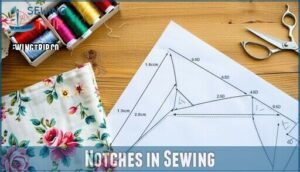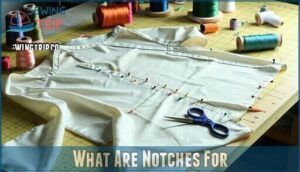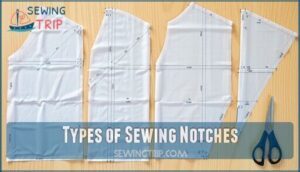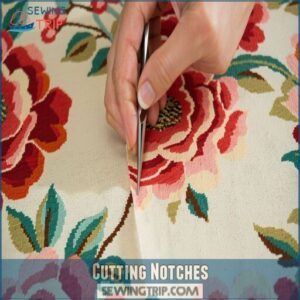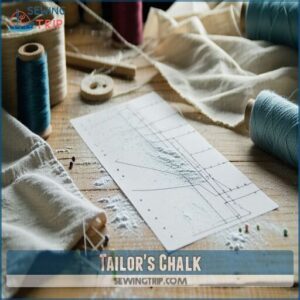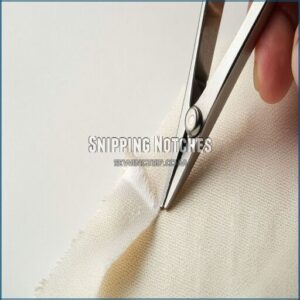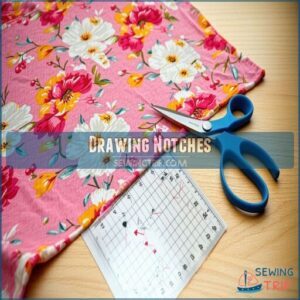This site is supported by our readers. We may earn a commission, at no cost to you, if you purchase through links.
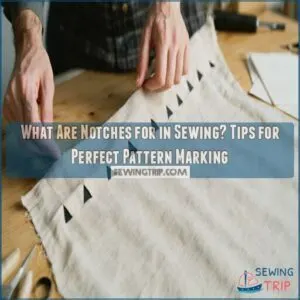 Notches in sewing are like tiny road signs on your fabric.
Notches in sewing are like tiny road signs on your fabric.
They help you match up pattern pieces accurately, ensuring your seams and designs align perfectly.
These small marks or snips, usually found on fabric edges, are essential for joining pieces correctly—especially on curves or tricky sections.
Single notches often show front pieces, while double notches indicate the back.
You can cut them outward like little triangles or snip them into the fabric.
Forgetting notches can make sewing a guessing game, so don’t skip them!
Mastering notches is a small step that leads to smoother, stress-free sewing sessions.
Table Of Contents
Key Takeaways
- Notches help you align fabric pieces accurately, preventing mismatched seams and ensuring a clean finish.
- They’re essential for marking seam allowances, design details, and fabric alignment, especially on curved or tricky sections.
- You can choose between cutting outward triangles, snipping into the fabric, or using chalk depending on the fabric type and project complexity.
- Using notches consistently makes sewing faster, easier, and more precise by reducing guesswork and improving assembly accuracy.
Notches in Sewing
Notches in sewing are small marks or cuts on fabric and patterns that guide you in aligning and assembling pieces correctly.
They guarantee seams match perfectly and help you keep your project on track during construction.
Purpose of Notches
Notches are small yet powerful guides in sewing.
Notches are the secret to sewing precision, aligning your pieces perfectly for a polished and professional finish every time.
They’re your alignment aid, helping guarantee seamless pattern assembly and accurate seam matching.
These pattern markings highlight key design details, fabric alignment points, and even balance points for curved pieces.
Sewing notches prevent misalignments, making garment construction precise and helping achieve a polished finish.
Think of them as your blueprint for perfect pattern matching.
Importance of Notches
You can think of sewing notches as your secret weapon for accurate work. They guide pattern alignment, ensuring seam matching and fabric alignment.
Here’s why they matter:
- They make garment assembly smoother and faster.
- They guarantee sewing accuracy by aligning pieces perfectly.
- They improve user satisfaction by reducing guesswork.
- They boost confidence with precise pattern markings for pattern matching every time.
Proper alignment relies on accurate pattern alignment, which is crucial for garment assembly and pattern matching to ensure a smooth and efficient sewing process.
Benefits of Notches
Properly placed pattern notches simplify assembly, ensuring alignment accuracy and boosting user satisfaction.
They’re like a GPS for sewing—guiding fabric pieces to fit perfectly.
Cutting notches marks seam allowance, aiding in sewing accuracy.
Fabric notches also guarantee fit assurance, even on curves.
Attention to design quality enhances your sewing experience, making precision adjustments easy and fostering confidence in every stitch.
What Are Notches For
When sewing patterns, notches serve as your guideposts, helping you match fabric sections perfectly.
Notches are your sewing GPS, guiding each fabric section into perfect alignment for a seamless and professional finish.
These small markers indicate where seams, darts, or design details like pleats and gathers should align.
Without them, piecing together a garment could feel like a puzzle missing key clues.
Pattern notches, whether triangles, diamonds, or small snips, guarantee accuracy, saving time and frustration during assembly.
Historically, notches were cut out as diamonds on vintage patterns, while modern patterns favor triangular shapes or simple snips into the seam allowance.
Fabric notches also assist with seam allowance accuracy, keeping your project neat and professional.
A key to preventing twisted seams is to understand how to sew notches.
In some cases, notching alternatives like chalk markings or thread tacks can maintain the fabric’s integrity, especially with delicate materials.
Omission of notches or misaligned ones risks mismatched seams, making adjustments a headache.
When used properly, notches bring stability and precision to your sewing process while reflecting an evolution in pattern-making techniques.
Notch Placement Techniques
Placing notches correctly guarantees your fabric pieces align accurately, saving you from mismatched seams. You’ll use simple techniques to mark seam allowances, design details, and curved sections with precision.
Seam Allowance Notches
Every sewing project benefits from neat seam allowance notches.
They help you align fabric edges precisely, even with varying allowances.
Here’s how to handle them effectively:
- Cut notches outward as tiny triangles for easy visibility.
- For corner notching, snip carefully to prevent tearing.
- Use a consistent style throughout.
- Leave room for seam adjustments.
- Always mark pattern notches clearly.
Design Detail Notches
Including design detail notches in your sewing patterns makes aligning features like pleats, pockets, and hems a breeze.
These tiny cuts or symbols guide you in placing pattern elements precisely, ensuring clean, professional results. Whether you’re handling gathers or tucks, notches simplify the process and improve clarity.
Here’s a quick guide:
| Detail | Use | Placement | Tip |
|---|---|---|---|
| Pleat Notches | Align pleats | Along pleat edges | Mark both top and bottom. |
| Pocket Placement | Position pockets | Side of body pieces | Double-check for symmetry. |
| Hem Alignment | Accurately fold hems | Bottom of fabric edge | Use consistent notches here. |
| Tucks Guidance | Position tucks | Across fabric width | Verify spacing marks clearly. |
Curve Notching
Curve notching is essential for sewing curves, especially in complex patterns. With a convex curve, you notch to reduce bulk; for a concave curve, you clip.
Follow these notch techniques:
- Use small, “V”-shaped cuts for accurate alignment.
- Walk the curve into place to check fit.
- Maintain tension control to avoid stretching.
- Space notches evenly.
- Work carefully for smooth results, ensuring a convex curve is properly managed.
Transfer Notches
For accurate pattern matching, transferring notches between fabrics is key.
Use tools like tailor’s chalk or snips, but consider fabric type to avoid damage.
Align pattern symbols carefully, ensuring notches stay visible.
Double-check placement for best results.
This simple accuracy method keeps pieces aligned, especially on tricky curves.
Explore marking alternatives, like thread tracing, for delicate fabrics or tight seam allowances, which helps in maintaining the integrity of the fabric, and is a key part of the pattern matching process.
Types of Sewing Notches
Notches come in a variety of styles, each with a specific purpose to make your sewing easier and more accurate.
From single notches to double ones, and even diamond or triangle shapes, understanding their differences helps you match fabric pieces perfectly, which involves complete concepts and accurate matching.
Diamond Notches
Diamond notches, a hallmark of vintage patterns, offer unmatched precision for aligning seams.
These pattern notches form symmetrical triangles that point outward, aiding accuracy during stitching. Though cutting notches this way demands careful handling, the results shine in complex designs.
Here’s how they help:
- Clear pattern symbols
- Seam alignment
- Enhanced notch visibility
- Easy identification guide
- Reliable cutting methods, which provide unmatched precision for aligning seams, and the notches also aid in seam alignment and offer clear pattern symbols.
Triangle Notches
Triangle notches, popular in modern patterns, are half-diamonds pointing outward and are cut into V-shaped wedges.
These enhance notch visibility, making alignment simpler, and are ideal for beginners due to their clarity during pinning and stitching.
When cutting notches, observe notch depth carefully to maintain seam integrity.
Snipping notches requires precision for accurate triangles, especially with sewing pattern notches.
| Key Aspect | Description |
|---|---|
| Cutting Direction | Outward, forming a visible V-shape. |
| Accurate Triangles | Essential for proper seam alignment. |
| Seam Integrity | Cuts should avoid weakening seams. |
| Notch Depth | Keep shallow for clean adjustments. |
| Modern Patterns | Commonly use triangle-shaped notches. |
Single Notches
Single notches are small yet mighty helpers in the context of sewing pattern marking.
They’re commonly placed at the side seams to identify the front of a pattern piece, preventing errors during assembly.
By snipping notches or using a pattern notcher, you’ll align fabric pieces effortlessly, and understanding their placement guarantees accuracy while preserving design intent in sewing projects.
Proper alignment prevents issues like twisted and misaligned seams, which is crucial for achieving professional results.
Double Notches
Double notches are your go-to markers for identifying back pattern pieces. They’re easy to spot and prevent mix-ups during assembly.
Use them to align:
- Back seams and panels for precise sewing.
- Correct sides of tricky garments like jackets.
- Areas needing detailed pattern alterations.
- Where fabric stretches, avoiding mistakes later.
Look for double notches to simplify complex sewing patterns, and use them to ensure precise sewing and avoid mistakes, making them a key tool for pattern alterations.
Marking Notches on Fabric
Marking notches on fabric helps you match your sewing pieces accurately and avoid misaligned seams.
You can use different tools like scissors, chalk, or markers to transfer these small but essential guides.
Cutting Notches
Cutting notches is simple but requires precision.
Use notching tools or snip outward triangles near seam allowances to align pattern pieces.
Keep snipping depth shallow to prevent fabric fraying.
Rotary cutters work best for straight edges but aren’t ideal for precise notching.
Remembering to pre-wash your fabric can prevent shrinkage after sewing.
Marking notches while fabric cutting saves time and guarantees your sewing techniques stay sharp and well-aligned.
Tailor’s Chalk
Tailor’s chalk is a smart alternative for sewing pattern marking.
It’s simple to use and works wonders on delicate fabrics.
Here’s why:
- Chalk Composition: Soft and precise for marking pattern pieces.
- Chalk Durability: Easy to remove without residue issues.
- Chalk Application: Draw light, visible lines for sewing pattern transfer.
Tailor’s marks? They’re removable and fuss-free!
Many sewers buy different types for various fabrics.
Snipping Notches
Snipping notches is a quick, simple way to mark sewing patterns. A small snip into the seam allowance helps guide alignment without disrupting pattern pieces.
Keep cuts shallow to avoid fabric fraying or seam weakening. This method works best with sturdy fabrics, but for delicate materials, consider snipping alternatives like marking tools to balance accuracy concerns and garment quality.
Many tools facilitate precise sewing notches to enhance the sewing process and ensure accurate alignment.
Drawing Notches
For a softer touch, try drawing notches with washable markers or chalk. This method avoids cutting into the fabric, perfect for beginners or delicate materials.
Temporary marks are quick to adjust and easy to remove. Consider using washable fabric pens for convenience.
Test markers on scraps first to prevent stains. Combine drawn notches with other sewing pattern marking methods for added accuracy and seamless alignment, ensuring a perfect finish.
Frequently Asked Questions (FAQs)
What is the purpose of notching?
Notching helps you align fabric pieces precisely during sewing.
It marks key points, like seams or design details, ensuring everything matches up perfectly.
With notches, you’ll sew confidently without worrying about mismatched edges or uneven seams, and have a more confident sewing experience.
What are the uses of notches?
Imagine road signs guiding you through unknown terrain; that’s what notches do in sewing.
They guarantee pieces align, mark seam allowances, and highlight design details like pleats, darts, or pockets—creating precision and ease while sewing.
Why is it important to notch a seam?
It’s vital to notch a seam because it guarantees proper alignment of fabric pieces, prevents stretching during sewing, and helps you match curves accurately.
This small step makes assembling garments easier and more precise, which is a complete concept that enhances the overall sewing process.
How are notches used to match up pieces of fabric?
Think of notches as the puzzle piece edges for fabric—they let you align seams perfectly by matching their marks.
Place them together, pin, and sew, they keep everything lined up and prevent mismatched seams, using notches to ensure accuracy.
What is the best way to mark notches on fabric?
Use small snips or mark with chalk for clean, visible notches.
Avoid cutting too deep to protect the seam’s strength.
Tailor’s tacks or fabric-safe pens work well for delicate materials like silk or leather.
Is it better to cut the notches inwards or outwards?
Cutting notches outward creates visible markers without compromising seam strength, like leaving breadcrumbs for alignment.
Snipping inward is faster but risks weakening fabric, especially on delicate seams.
Choose outward cuts for precision or inward for speed.
How can I ensure that the notches are accurately placed?
To accurately place notches, align pattern pieces carefully and double-check seamlines.
Mark notches clearly on both fabric and paper patterns.
Use small cuts, chalk, or tailor’s tacks, and measure distances precisely for consistency.
What type of notches should be used for highly fraying fabrics?
Fray-fighting fabrics call for outward triangle notches.
These minimize fabric tearing while staying visible for alignment.
Avoid snipping inward, as it weakens edges.
Chalk markings or thread tacks work too, keeping your seams safe and sturdy.
How do notches affect fabric grain alignment?
Notches keep fabric on track by helping you align pattern pieces perfectly with the grain.
They guarantee your garment hangs right, doesn’t twist, and maintains shape, especially on tricky bias cuts or curves.
What tools improve notch marking precision?
Imagine drawing a perfect map—tools like tailor’s chalk, marking pencils, or pattern notching pliers help you mark notches precisely.
Pair them with a steady hand to guarantee accuracy without weakening delicate fabrics, using tools like tailor’s chalk to ensure the best results.
Conclusion
Don’t underestimate the value of notches—they’re your guide to precise sewing.
While they might seem small or unnecessary, they play a big role in keeping your seams aligned and patterns accurate.
Knowing what notches are for in sewing guarantees smooth construction, especially on curves and tricky areas.
Whether you cut, snip, or mark your notches, use them consistently to avoid guesswork, and mastering this detail will make your sewing projects easier, faster, and stress-free.

